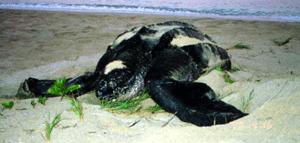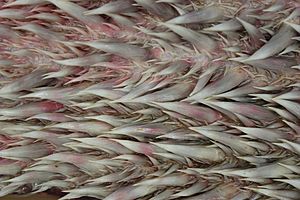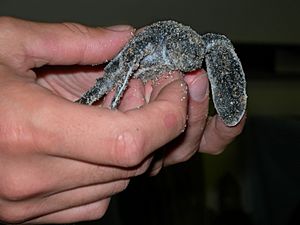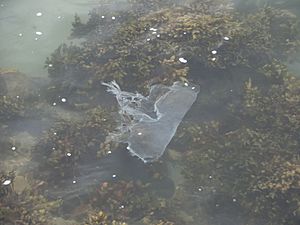Leatherback sea turtle facts for kids
Quick facts for kids Leatherback sea turtle |
|
|---|---|
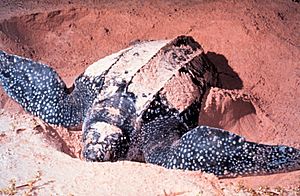 |
|
| Conservation status | |
| Scientific classification | |
| Kingdom: | |
| Class: | |
| Order: | |
| Suborder: | |
| Family: |
Dermochelyidae
|
| Genus: |
Dermochelys
|
| Binomial name | |
| Dermochelys coriacea |
|
The leatherback sea turtle is the largest of all living sea turtles. It is the fourth largest modern reptile behind three crocodilians.
Adults average 1–1.75 metres (3.3–5.7 ft) in shell length, 1.83–2.2 metres (6.0–7.2 ft) in total length and weigh 250 to 700 kilograms (550 to 1,540 lb). The largest ever found was over 3 metres (9.8 ft) from head to tail and weighed 916 kilograms (2,019 lb). It was found on a beach on the west coast of Wales.
The eggs and young are often eaten by predators, but the adults can defend themselves aggressively. Only the largest sea predators can tackle a leatherback successfully.
Leatherback turtles are one of the deepest diving marine animals. They have been recorded diving to depths as great as 1,280 metres (4,200 ft).
They are also the fastest-moving reptiles. The 1992 edition of the Guinness Book of World Records lists the leatherback turtle moving at 35.28 kilometres per hour (21.92 mph) in the water. Usually, they swim at 0.5–2.8 metres per second (1.1–6.3 mph).
They can live as far north as Alaska and Norway and as far south as the Cape of Good Hope in Africa and the southernmost tip of New Zealand. The leatherback is found in all tropical and subtropical oceans, and it also goes well into the Arctic Circle.
Very little is known about how long they live. Some reports say "30 years or more", while others say "50 years or more".
Contents
Ecology and life history
Habitat
Leatherback turtles can be found primarily in the open ocean. Scientists tracked a leatherback turtle that swam from Jen Womom beach of Tambrauw regency in West Papua province of Indonesia to the U.S. in a 20,000 km (12,000 mi) foraging journey over a period of 647 days. Leatherbacks follow their jellyfish prey throughout the day, resulting in turtles "preferring" deeper water in the daytime, and shallower water at night (when the jellyfish rise up the water column). This hunting strategy often places turtles in very frigid waters. One individual was found actively hunting in waters that had a surface temperature of 0.4 °C. (32.72 °F). Leatherback turtles are known to pursue prey deeper than 1000 m—beyond the physiological limits of all other diving tetrapods except for beaked whales and sperm whales.
Their favored breeding beaches are mainland sites facing deep water, and they seem to avoid those sites protected by coral reefs.
Feeding
Adult D. coriacea turtles subsist almost entirely on jellyfish. Due to their obligate feeding nature, leatherbacks help control jellyfish populations. Leatherbacks also feed on other soft-bodied organisms, such as tunicates and cephalopods.
Pacific leatherbacks migrate about 6,000 mi (9,700 km) across the Pacific from their nesting sites in Indonesia to eat California jellyfish. One cause for their endangered state is plastic bags floating in the ocean. Pacific leatherback sea turtles mistake these plastic bags for jellyfish; an estimated one-third of adults have ingested plastic. Plastic enters the oceans along the west coast of urban areas, where leatherbacks forage, with Californians using upward of 19 billion plastic bags every year.
Several species of sea turtles commonly ingest plastic marine debris, and even small quantities of debris can kill sea turtles by obstructing their digestive tracts. Nutrient dilution, which occurs when plastics displace food in the gut, affects the nutrient gain and consequently the growth of sea turtles. Ingestion of marine debris and slowed nutrient gain leads to increased time for sexual maturation that may affect future reproductive behaviors. These turtles have the highest risk of encountering and ingesting plastic bags offshore of San Francisco Bay, the Columbia River mouth, and Puget Sound.
Lifespan
Very little is known of the species' lifespan. Some reports claim "30 years or more", while others state "50 years or more". Upper estimates exceed 100 years.
Death and decomposition
Dead leatherbacks that wash ashore are microecosystems while decomposing. In 1996, a drowned carcass held sarcophagid and calliphorid flies after being picked open by a pair of Coragyps atratus vultures. Infestation by carrion-eating beetles of the families Scarabaeidae, Carabidae, and Tenebrionidae soon followed. After days of decomposition, beetles from the families Histeridae and Staphylinidae and anthomyiid flies invaded the corpse, as well. Organisms from more than a dozen families took part in consuming the carcass.
Life history
Predation
Leatherback turtles face many predators in their early lives. Eggs may be preyed on by a diversity of coastal predators, including ghost crabs, monitor lizards, raccoons, coatis, dogs, coyotes, genets, mongooses, and shorebirds ranging from small plovers to large gulls. Many of the same predators feed on baby turtles as they try to get to the ocean, as well as frigatebirds and varied raptors. Once in the ocean, young leatherbacks still face predation from cephalopods, requiem sharks, and various large fish. Despite their lack of a hard shell, the huge adults face fewer serious predators, though they are occasionally overwhelmed and preyed on by very large marine predators such as killer whales, great white sharks, and tiger sharks. Nesting females have been preyed upon by jaguars in the American tropics.
Apparently, the adult leatherback aggressively defends itself at sea from predators. A medium-sized adult was observed chasing a shark that had attempted to bite it and then turned its aggression and attacked the boat containing the humans observing the prior interaction. Dermochelys juveniles spend more of their time in tropical waters than do adults.
Adults are prone to long-distance migration. Migration occurs between the cold waters where mature leatherbacks feed, to the tropical and subtropical beaches in the regions where they hatch. In the Atlantic, females tagged in French Guiana have been recaptured on the other side of the ocean in Morocco and Spain.
Offspring
While other sea turtle species almost always return to their hatching beach, leatherbacks may choose another beach within the region. They choose beaches with soft sand because their softer shells and plastrons are easily damaged by hard rocks. Nesting beaches also have shallower approach angles from the sea. This is a vulnerability for the turtles because such beaches easily erode. They nest at night when the risk of predation and heat stress is lowest. As leatherback turtles spend the vast majority of their lives in the ocean, their eyes are not well adapted to night vision on land. The typical nesting environment includes a dark forested area adjacent to the beach. The contrast between this dark forest and the brighter, moonlit ocean provides directionality for the females. They nest towards the dark and then return to the ocean and the light.
Females excavate a nest above the high-tide line with their flippers. One female may lay as many as nine clutches in one breeding season. About nine days pass between nesting events. Average clutch size is around 110 eggs, 85% of which are viable. After laying, the female carefully back-fills the nest, disguising it from predators with a scattering of sand.
Development of offspring
Cleavage of the cell begins within hours of fertilization, but development is suspended during the gastrulation period of movements and infoldings of embryonic cells, while the eggs are being laid. Development then resumes, but embryos remain extremely susceptible to movement-induced mortality until the membranes fully develop after incubating for 20 to 25 days. The structural differentiation of body and organs (organogenesis) soon follows. The eggs hatch in about 60 to 70 days. As with other reptiles, the nest's ambient temperature determines the sex of the hatchings. After nightfall, the hatchings dig to the surface and walk to the sea.
Leatherback nesting seasons vary by location; it occurs from February to July in Parismina, Costa Rica. Farther east in French Guiana, nesting is from March to August. Atlantic leatherbacks nest between February and July from South Carolina in the United States to the United States Virgin Islands in the Caribbean and to Suriname and Guyana.
Importance to humans
People around the world still harvest sea turtle eggs. Asian exploitation of turtle nests has been cited as the most significant factor for the species' global population decline. In Southeast Asia, egg harvesting in countries such as Thailand and Malaysia has led to a near-total collapse of local nesting populations. In Malaysia, where the turtle is practically locally extinct, the eggs are considered a delicacy.
They are also a major jellyfish predator, which helps keep populations in check. This bears importance to humans, as jellyfish diets consist largely of larval fish, the adults of which are commercially fished by humans.
Cultural significance
The turtle is known to be of cultural significance to tribes all over the world. The Seri people, from the Mexican state of Sonora, find the leatherback sea turtle culturally significant because it is one of their five main creators. The Seri people devote ceremonies and fiestas to the turtle when one is caught and then released back into the environment. The Seri people have noticed the drastic decline in turtle populations over the years and created a conservation movement to help this. The group, made up of both youth and elders from the tribe, is called Grupo Tortuguero Comaac. They use both traditional ecological knowledge and Western technology to help manage the turtle populations and protect the turtle's natural environment.
In the Malaysian state of Terengganu, the turtle is the state's main animal and is usually seen in tourism ads.
On the South Island of New Zealand's Banks Peninsula the leatherback turtle has great spiritual significance to the Koukourārata hapū of te Rūnanga o Ngāi Tahu, as well as wider significance in Te Ao Māori and to the peoples of greater Polynesia according to the protocols of each rohe. In 2021, a leatherback sea turtle was laid to rest by New Zealand's Department of Conservation in a hilltop cave on the Peninsula's Horomaka Island dug by hapū and in accordance with their rohe's ley lines, according to New Zealand's state broadcaster, Radio New Zealand.
Conservation
Leatherback turtles have few natural predators once they mature; they are most vulnerable to predation in their early life stages. Birds, small mammals, and other opportunists dig up the nests of turtles and consume eggs. Shorebirds and crustaceans prey on the hatchlings scrambling for the sea. Once they enter the water, they become prey to predatory fish and cephalopods.
Leatherbacks have slightly fewer human-related threats than other sea turtle species, however, turtle-fishery interactions may play a larger role than previously recognized. Their flesh contains too much oil and fat to be considered palatable, reducing the demand. However, human activity still endangers leatherback turtles in direct and indirect ways. Directly, a few are caught for their meat by subsistence fisheries. Nests are raided by humans in places such as Southeast Asia. In the state of Florida, there have been 603 leatherback strandings between 1980 and 2014. Almost one-quarter (23.5%) of leatherback strandings are due to vessel-strike injuries, which is the highest cause of strandings.
Light pollution is a serious threat to sea turtle hatchlings which have a strong attraction to light. Human-generated light from streetlights and buildings causes hatchlings to become disoriented, crawling toward the light and away from the beach. Hatchlings are attracted to light because the lightest area on a natural beach is the horizon over the ocean, the darkest area is the dunes or forest. On Florida's Atlantic coast, some beaches with high turtle nesting density have lost thousands of hatchlings due to artificial light.
Many human activities indirectly harm leatherback turtles. The species is occasionally caught as bycatch. Entanglement in lobster pot ropes is another hazard the animals face. As the largest living sea turtles, turtle excluder devices can be ineffective with mature adults. In the eastern Pacific alone, a reported average of 1,500 mature females were accidentally caught annually in the 1990s. Pollution, both chemical and physical, can also be fatal. Many turtles die from malabsorption and intestinal blockage following the ingestion of balloons and plastic bags which resemble their jellyfish prey. Chemical pollution also has an adverse effect on Dermochelys. A high level of phthalates has been measured in their eggs' yolks. Leatherback sea turtles ranging from 1985-2007 were autopsied for the existence of plastic in the gastrointestinal tract. It was discovered that 34% of the cases had plastic blockage.
Due to their diet consisting of gelatinous zooplankton, the leatherback sea turtle consumes high amounts of salt. Different life stages of dead individuals from the western Atlantic Ocean were used to test the concentrations of various contaminants found in the salt glands and red blood cells. These contaminants include arsenic, cadmium, lead, mercury, and selenium. The contaminants were found in higher concentrations in the blood compared to the salt gland secretions. The length of the curve in the carapace of a turtle had a direct correlation with cadmium and mercury concentrations. Salt glands and red blood cells are potentially susceptible to high levels of contaminants being found in the oceans.
Global initiatives
D. coriacea is listed on CITES Appendix I, which makes export/import of this species (including parts) illegal. It has been listed as an EDGE species by the Zoological Society of London.
The species is listed in the IUCN Red List of Threatened Species as VU (Vulnerable), and additionally with the following infraspecific taxa assessments:
- East Pacific Ocean subpopulation: CR (Critically Endangered)
- Northeast Indian Ocean subpopulation: DD (Data Deficient)
- Northwest Atlantic Ocean subpopulation: EN (Endangered)
- Southeast Atlantic Ocean subpopulation: DD (Data Deficient)
- Southwest Atlantic Ocean subpopulation CR (Critically Endangered)
- Southwest Indian Ocean subpopulation CR (Critically Endangered)
- West Pacific Ocean subpopulation CR (Critically Endangered)
Conserving Pacific and Eastern Atlantic populations were included among the top-ten issues in turtle conservation in the first State of the World's Sea Turtles report published in 2006. The report noted significant declines in the Mexican, Costa Rican, and Malaysian populations. The eastern Atlantic nesting population was threatened by increased fishing pressures from eastern South American countries.
The Leatherback Trust was founded specifically to conserve sea turtles, specifically its namesake. The foundation established a sanctuary in Costa Rica, the Parque Marino Las Baulas.
National and local initiatives
The leatherback sea turtle is subject to different conservation laws in various countries.
The United States listed it as an endangered species on 2 June 1970. The passing of the Endangered Species Act of 1973 ratified its status. In 2012, the National Oceanic and Atmospheric Administration designated 41,914 square miles of Pacific Ocean along California, Oregon, and Washington as "critical habitat". In Canada, the Species at Risk Act made it illegal to exploit the species in Canadian waters. The Committee on the Status of Endangered Wildlife in Canada classified it as endangered. Ireland and Wales initiated a joint leatherback conservation effort between Swansea University and University College Cork. Funded by the European Regional Development Fund, the Irish Sea Leatherback Turtle Project focuses on research such as tagging and satellite tracking of individuals.
Earthwatch Institute, a global nonprofit that teams volunteer with scientists to conduct important environmental research, launched a program called "Trinidad's Leatherback Sea Turtles". This program strives to help save the world's largest turtle from extinction in Matura Beach, Trinidad, as volunteers work side by side with leading scientists and a local conservation group, Nature Seekers. This tropical island off the coast of Venezuela is known for its vibrant ethnic diversity and rich cultural events. It is also the site of one of the most important nesting beaches for endangered leatherback turtles, enormous reptiles that can weigh a ton and dive deeper than many whales. Each year, more than 2,000 female leatherbacks haul themselves onto Matura Beach to lay their eggs. With leatherback populations declining more quickly than any other large animal in modern history, each turtle is precious. On this research project, Dennis Sammy of Nature Seekers and Scott Eckert of Wider Caribbean Sea Turtle Conservation Network work alongside a team of volunteers to help prevent the extinction of leatherback sea turtles.
Several Caribbean countries started conservation programs, such as the St. Kitts Sea Turtle Monitoring Network, focused on using ecotourism to highlight the leatherback's plight. On the Atlantic coast of Costa Rica, the village of Parismina has one such initiative. Parismina is an isolated sandbar where a large number of leatherbacks lay eggs, but poachers abound. Since 1998, the village has been assisting turtles with a hatchery program. The Parismina Social Club is a charitable organization backed by American tourists and expatriates, which collects donations to fund beach patrols. In Dominica, patrollers from DomSeTCo protect leatherback nesting sites from poachers.
Mayumba National Park in Gabon, Central Africa, was created to protect Africa's most important nesting beach. More than 30,000 turtles nest on Mayumba's beaches between September and April each year.
In mid-2007, the Malaysian Fisheries Department revealed a plan to clone leatherback turtles to replenish the country's rapidly declining population. Some conservation biologists, however, are skeptical of the proposed plan because cloning has only succeeded on mammals such as dogs, sheep, cats, and cattle, and uncertainties persist about cloned animals' health and lifespans. Leatherbacks used to nest in the thousands on Malaysian beaches, including those at Terengganu, where more than 3,000 females nested in the late 1960s. The last official count of nesting leatherback females on that beach was recorded to be a mere two females in 1993.
In Brazil, reproduction of the leatherback turtle is being assisted by the Brazilian Institute of Environment and Renewable Natural Resources' projeto TAMAR (TAMAR project), which works to protect nests and prevent accidental kills by fishing boats. The last official count of nesting leatherback females in Brazil yielded only seven females. In January 2010, one female at Pontal do Paraná laid hundreds of eggs. Since leatherback sea turtles had been reported to nest only at Espírito Santo's shore, but never in the state of Paraná, this unusual act brought much attention to the area, biologists have been protecting the nests and checking their eggs' temperature, although it might be that none of the eggs are fertile.
Australia's Environment Protection and Biodiversity Conservation Act 1999 lists D. coriacea as vulnerable, while Queensland's Nature Conservation Act 1992 lists it as endangered.
Images for kids
See also
 In Spanish: Tortuga laúd para niños
In Spanish: Tortuga laúd para niños



